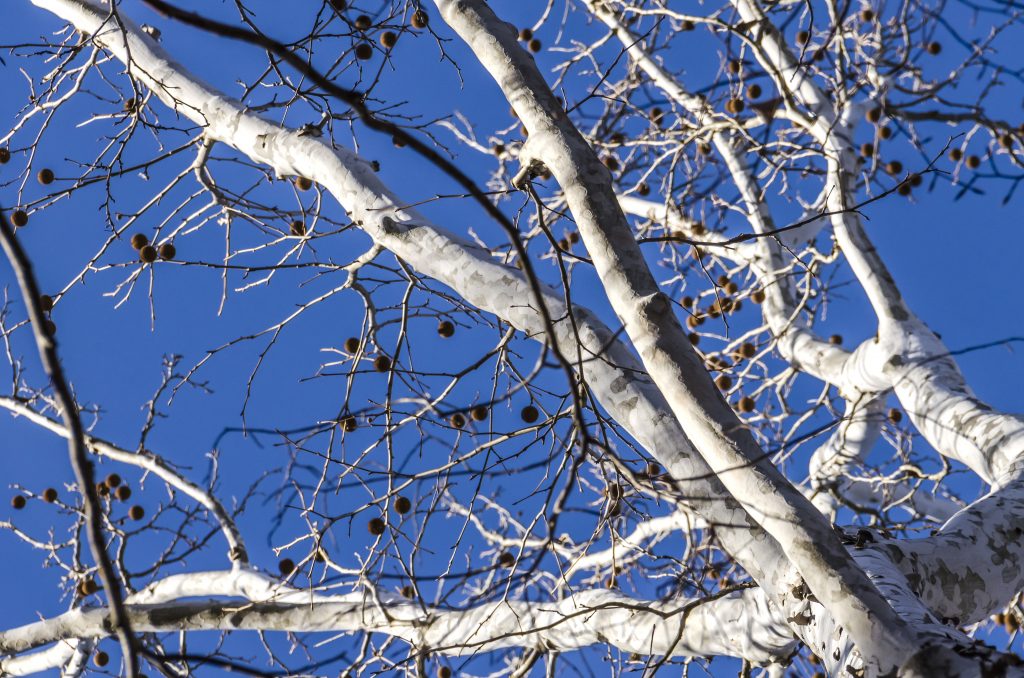
No. this is not about Lithuanian anti-Soviet partisans. This is about my local forest brothers… the American Sycamore trees growing behind my house. I consider them my brothers because they grew from bare ground only after my family and I moved into this house in 1996. We grew together in this Virginia hollow along a small tributary of Aquia Creek.
When I chose this lot, it was all bare ground, newly graded at the bottom of a still gravel road. I checked the county land use plans and saw that the woods and stream behind the lot were to forever stay woods and stream because of an endangered freshwater mussel. What clinched the decision was the appearance of a wild rabbit who approached me as I surveyed the site. I took this as a sign that the forest blessed the eventual presence of myself and my family.
After moving into my new home, I watched how the graded land behind the house evolved through a natural evolution of flora. The first trees to appear were rapidly growing black locusts and some redbuds. They remain but my back yard is now dominated by American Sycamores. I am amazed by their size after only a quarter of a century. When fully leafed out in the summer, they loom large over my garden shed, gazebo and back deck. I find their immenseness comforting. SWMBO is somewhat intimidated by their mass. Their fall foliage is not all that impressive, it yellows, browns, then falls to the ground. But that’s when these trees really come into their own. Their smooth light grey bark shines in the winter sunlight. Enjoy the photos.
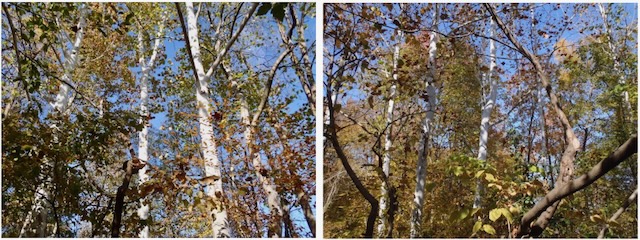
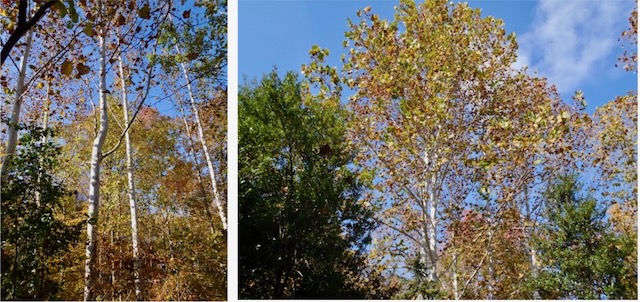
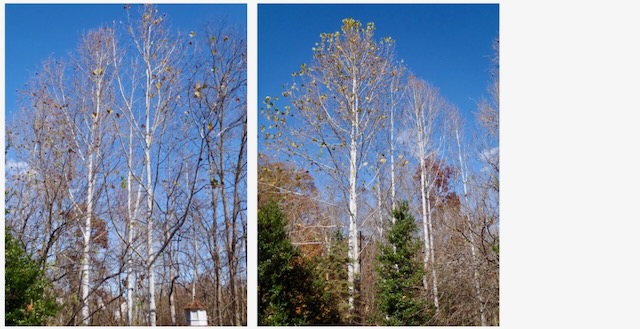
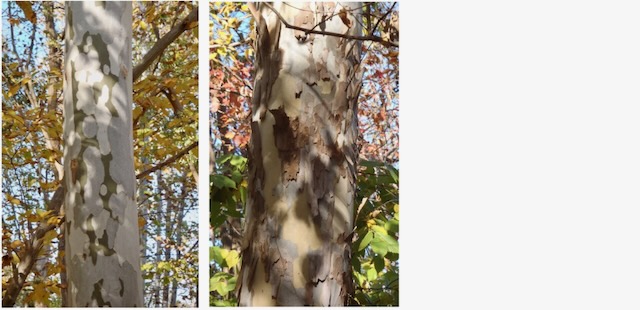
The bark of the sycamore is not always a uniformly smooth light grey. It sometimes takes on the appearance of a camouflage pattern as the older outer bark sheds off in irregular patterns. Eventually the lower bark becomes rough and takes on the appearance of many other forest trees.
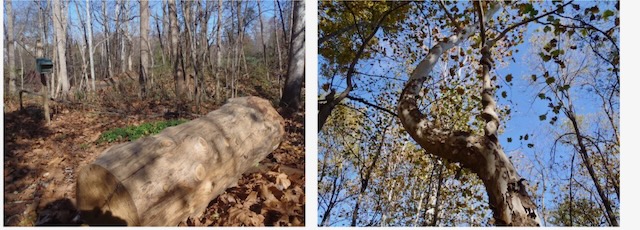
On the left is my sitting log made from a section of a large Blue Spruce I had to remove from my front yard. SWMBO didn’t appreciate me climbing the tree with hatchet and saw, but that was the easy part. Removing the stump with axe, shovel, wedges and sledge hammer was a real bear. From my sitting log, perhaps you can make out a particularly odd shaped sycamore in the distance.
On the right is a close up of that sycamore that bears witness to an epic forest struggle and eventual triumph. Years ago this tree was being strangled by a vine. It could have been the end of this tree, but the sycamore outwitted the vine. It grew a new main trunk below the point where the vine started wrapping around the tree and continued to grow strong enough to break the grip of the vine. It is a natural forest monument to the perseverance of life.
Another reason for dedicating this posting to my brother sycamores is that this is the “Year of the Sycamore” as designated by our state arboretum.
In honor of Arbor Day, “the nation’s tree planting holiday,” Blandy arborists and representatives from the Department of Forestry will plant an American Sycamore tree at the Arboretum on Friday, April 29. The tree will be added to a tree and shrub collection that dates to the 1930s. The Arboretum’s 2022 Tree of the Year was selected after deliberation by Curator T’ai Roulston and Blandy arborists. “A vital part of our mission is to practice and promote tree education, science, and conservation,” said Roulston. “Through research and public programming, we want to share with everyone – of all ages – how important trees are to the environment.” According to Roulston, the sycamore was selected for its value as one of the largest trees in the eastern U.S. and for its exfoliating bark which creates a beautiful, mottled layer of light greens, grays, and browns.
The American Sycamore is a massive tree, with heavy, spreading branches that can grow to a height of 70-100 feet with a canopy spread of 60-80 feet. Its leaves, which often measure up to eight inches across, help make the sycamore one of our most impressive shade trees. Sycamores are also called buttonwood or buttonball trees because of the one-inch balls that hang from the tree through the winter months and then fall each spring. Sycamore is a large deciduous species of wide distribution across the eastern and central U.S. and is used for lumber and pulpwood. Sycamore seeds are eaten by wildlife, and its hollowed limbs are often used as nesting sites for birds and mammals. In the wild, it is most often found in riparian areas, but as a cultivated tree it can grow well in upland sites. It is often used as a street tree, sometimes forming an impressive allée – a tunnel of green lined with streaked white trunks. The downtown area of our local city of Winchester gets much of its natural grandeur from these massive trees.
In 1744, a Shenandoah Valley settler named Joseph Hampton supposedly lived with his two sons for most of the year in a hollow sycamore in Clarke County, VA. And in 1770, while surveying for the Kanawha Canal, George Washington recorded in his journal a sycamore tree with a trunk that measured almost 45 feet in circumference.
https://blandy.virginia.edu/2022-tree-year-american-sycamore
I look forward to growing older with my brothers over the next quarter century. I know they’ll be here. I hope I’ll be around to celebrate with them. If not, my sons will.
TTG

Thank you, TTG.
I learned valuable lessons. Disambiguation of “Blandy” in Wikipedia.
An atomic cake. What a lovely hat his wife wore. He said “I am not an atomic playboy.” It concerned his responsibilities supervising a detonation on Bikini, an atoll, and the name of a swimming suit it was in my youth my good fortune to observe being worn. And he has at least one ship named in his honor.
https://en.wikipedia.org/wiki/William_H._P._Blandy
The sad story of Mary Blandy. Was her execution necessary? Poisoned her father by adding a love potion given to her by her bigamist fiance. What a shame.
https://en.wikipedia.org/wiki/Mary_Blandy
The name derives from the ancient Greek συκόμορος (sūkomoros) meaning “fig-mulberry”.
https://en.wikipedia.org/wiki/Sycamore
There are a number of biblical references to the tree.
I no longer have brothers as I live alone, like Madame Broshkina, performed by Alla Pugacheva, and my ship has sailed, as she said in her song which I graciously once provided a link to a performance of in which the rulers of Belarus, Russia and Ukraine looked on and applauded.
I am pleased to hear that you treat trees with the reverence I was once capable of attending to. Now, I walk by them hardly noticing, which is a pity. I wonder what happened.
Look at the hat worn by the wife of Admiral Blandy back then. Ask yourself. What happened? Or not. Thank you very much again.
The house we recently purchased is part of a new development. We only have a quarter of an acre. Former farmland so it was bare before I hired a landscaper to install a couple of trees: 2 lilacs trees and 1 plum tree in the front, 2 tall Princeton elms for shade in the back, 3 baby black gums for bees and 2 Zelkovas to round it out. The black gums have a strong triangular shape and are spread between everything else, which will fill out with a vase shape. In a couple of years I hope I’ll have a green screen between my house and the electric tower far behind the property. There’s also a pagoda dogwood on the side. We’ve seen Canadian geese, wood ducks and herons thanks to the pond. Deer and wild hare. In the spring the peepers and frogs raise a chorus and pretty soon the small coyote pack, if they’re still alive, will start their crazy, ululating yowls on winter nights.
“What clinched the decision was the appearance of a wild rabbit who approached me as I surveyed the site. I took this as a sign that the forest blessed the eventual presence of myself and my family.”
I met my husband’s family during winter in Eastport, Maine. Eastport is a rocky island connected to the mainland by a causeway. I didn’t know it at the time but there’s a reservation nearby. After staying a few days I was a little bored so I decided to walk the woods around the house. I felt like I was being watched when I stepped off the road and into a grove of pines. It didn’t take long to feel like someone or something wanted me to Go. Away. I felt like an intruder, turned around and left. I recounted my experience to my husband and his family but no one seemed to understand.
I blame my Spanish blood and like to think the Old Gods sleep lightly.
Lesly,
Our developer added two trees to every lot in the development. Most are now doing fine giving us wonderfully shaded streets. We got a red maple which dominates the front yard. The original ornamental plum went down in a hurricane years ago. I replaced it with a Kwanzan Cherry. It’s also doing well. I recently added another on the other side of the driveway. They will complement the many neighborhood Yoshino Cherries. I think our neighborhood rivals the Tidal Basin in DC during the annual Cherry Festival.
I’ve also added ten free native trees from the Arbor Day Foundation. Some made it. Some didn’t. Between these and the numerous hollies I’ve planted, the front porch is fairly secluded even though I live on a corner. And the birds and squirrels are countless.
TTG,
Kwanzan cherries are lovely. Unfortunately I don’t think any cherry tree would do well in my compacted, hard clay soil.
I plan to slowly replace the developer’s Kentucky bluegrass with a drought tolerant tall fescue mix, then see what else I can add to my smaller lot besides the front bed with native flowers and 2 bushes. Maybe with the HOA’s approval some day my front lawn can be a little more secluded like yours.
I read somewhere that the first American lawn seed bags had a clover mix to help fix the soil, then wealthy homeowners set a trend by removing their beds to show they could afford to buy all their food. IMO we could save a lot of time, water and money if we learned to grow some of our own food.
I use to have a tall one when living just outside Camp Pendleton north of San Diego years ago. Loved it. Not sure what variety it was? But my neighbor hated it for all the litter it dropped on his side of the fence.
Rare up here in coastal WA state. I wonder if those false-sycamore-maples would like it here?
Leith,
Yes, the leaf litter from these trees can be overwhelming, but my trees are right where I want them. They’re building up the forest humus quickly. Leaf litter on my lawn never bothered me. I just mulch it in place as the season progresses.
I would imagine those sycamore maples would do fine in Washington. I think they’re known as English Sycamores in the UK and across Europe. They’re really maples rather than sycamores.
“When we’ve been here ten thousand years
still bright as the shining sun
there’ll still be time to praise the lord
as when we’ve just begun”
We are just a small part of god’s nature, whatever god is. Tis well we accept that.
TTG….Thanks for sharing that…A Refreshing change ..that I Enjoyed.Reading..
.Since I have always Bonded With The Forests and Streams ..I Now Bond with My Sightings of Eagles..over our Home..or Close by..SYMBO Loves running through piles of Marle leafs..and bringing home Colorful Bouquets..
Since I Was Old enough to Explore..or Ride My Schwinn for Longer Explorations…To My High Elevation hikes Through Old Growth..Knowing trees are Your Brothers..is a Spiritual Experience..and A Gift…Be Well..Happy Thanksgiving Regards,,
JT
TTG… What you wrote ..Also Reminded Me of a My Sioux Indian Friends..
And a framed Prayer By A Lakota Sioux Chief…Yellow Lark..in 1889
I Keep.on my Wall..
” O GREAT SPIRIT ”
Whose Voice I Hear in the Winds..And Whose Breath
Gives Life to All The World…Hear Me…!
I Am Small and Weak..I Need Your Strength,,and Wisdom
Let Me Walk in Beauty..And Make My Eyes..
Ever behold the Red and Purple Sunset…
Let My Hands ..respect the things you have Made
And My Ears Sharp,,To Hear Your Voice…
Let Me Be Wise..So That I Understand..
The Things you Have Taught My People..
Let Me Learn….The Lessons You Have Hidden
In Every Leaf…And Rock..
I Seek Strength..Not to Be Greater than My Brother
But To Fight My Greatest Enemy…..MYSELF…
Make Me Always Ready To Come to You..
With Clean Hands…And Straight Eyes..
So When My LIFE Fades…..As The Setting Sunset
My Spirit May come to YOU..Without Shame..
JT..
SWMBO didn’t appreciate me climbing the tree with hatchet and saw, but that was the easy part.
She does not have a good head for heights, is not free from giddiness? That would be easier to ask in German, she is not “schwindelfrei”? Is there a shorter way to ask in English/American too?
LeaNder,
SWMBO is just afraid I could fall out of the tree and break my neck. I suppose I could. But I could also die in a fiery crash picking up pizza. I’m fairly skilled in accepting and mitigating risk. I’ve had a lot of practice.
This fear is a normal and prudent reaction on SWMBO’s part. I acknowledge it and take it into account. For her sake, I temper my risk taking but i can’t and won’t totally eliminate it.
Years ago this tree was being strangled by a vine. It could have been the end of this tree, but the sycamore outwitted the vine. It grew a new main trunk below the point where the vine started wrapping around the tree and continued to grow strong enough to break the grip of the vine.
This is a very, very fascinating story for me, TTG. Ages, and ages ago I visited my favorite cousin and his wife in France. At one point we talked about trees and vine, or whatever seemed to feed on the tree by winding around it. My cousin perceived it different then me, as some type of benevolent co-existancew. I did perceive it as you describe it above, as strangling, intending to kill the host.*
Are there different types of “vine” I wonder at this point in time?
* …
LeaNder ,
Vines of all kinds are bad for trees. This short article explains some of it.
https://www.wvtf.org/news/2017-05-01/killer-vines-attack-virginia-trees-residents-fight-back
Feral English Ivy is a tree killer out here. I cut down all I can reach. Then plaster the cuts with stumprot, else it grows back worse.
Dear, those seem to be very aggressive types. Of course during the last years traveling with my mother and brother mostly France, Swiss, Austria, Italy and beyond part of what makes landscape beautiful is based partly on a lot of hard work. 😉
I love your story about the fight of the tree with the vine. I once fought what you may call bindweeds or morning glories. Beautiful flowers really. Digged one two to three meters (foot, inches?) into the earth to get rid of the roots. Did not help, by now they have killed one of my late mothers roses.
But I see even bindweed might be called vine in the US, if I trust Wiki that is.
Besides: please keep your fingers crossed. This time around I am working on my floor. Not quite sure if I am not too old for such matters. 😉
LeaNder,
As you work on your floor, please use sufficient padding for your knees. I now use a rolled up closed cell sleeping pad. It may seen like overkill, but your knees will thank you for the effort. Also, pace yourself. Neither of us are as young and indestructible as we once were.
Thanks for describing your appreciation of reality. Not many are so lucky as regards the space you have but all can experience the connection between the mind and existence found in meditation, regardless of surroundings. Trees are to be preferred, ir course.
Re vines: I have been doing volunteer trail maintenance in a large NW forest park. Invasive English ivy will eventually climb up into the highest tree branches. With rain and wind, the wet ivy becomes heavy and will bring down large trees.
We spend many hours going into the park to cut ivy around the tree trunks. The above ivy vines then die and rot off….Works for awhile. The ivy is insistent, tho.
Al,
I see a lot of trees on the front lawns of old houses here covered by English Ivy. One way or another, those trees are doomed. That ivy was planted as landscaping years ago. I planted some years ago, but have since torn it out and destroyed it. Every year I search for remnants to destroy. It’s my penance.
This from the English Wikipedia on Hedera (Ivy) claims that as regards danger to trees it is more a problem in North America than Europe due to a lack of natural pests.
————-
Much discussion has involved whether or not ivy climbing trees will harm them. In Europe, the harm is generally minor although there can be competition for soil nutrients, light, and water, and senescent trees supporting heavy ivy growth can be liable to windthrow damage.[4] The UK’s Woodland Trust says “Ivy has long been accused of strangling trees, but it doesn’t harm the tree at all, and even supports at least 50 species of wildlife.”[6] Harm and problems are more significant in North America, where ivy is without the natural pests and diseases that control its vigour in its native continents; the photosynthesis or structural strength of a tree can be overwhelmed by aggressive ivy growth leading to death directly or by opportunistic disease and insect attacks.[13]
———-
See the section Problems and Dangers, subsection On Trees.
https://en.wikipedia.org/wiki/Hedera
Following that is the topic of Invasive Exotic which is very interesting. Rabbits were a terrible nuisance in Australia. They also amused greatly little children across the United States through the intervention of one Bugs Bunny. I have commissioned a board of inquiry to establish his actual given name for which the diminutive Bugs refers.
F&L,
It seems every year we have a new invasive species to prep for. This year the spotted lanternfly from Asia made a news debut. You can’t prep for every possibility but I recommend anyone planting trees research the pros/cons of all available species, including hybridized species, for disease and pest resistance, as well as looking up native options.
We had property in northern Idaho, grand-dad used go out in the spring to sprinkle iron filings near the roots of the birchs in the facing hillside, which caused the ones which he did it to to have brilliant red leaves in the fall. He didn’t use much on each tree, just a few handfuls scattered on the ground over the roots and iron is harmless. By carefully selecting the trees in the facing hillside and varying the amounts of iron he painted a spectacular picture for the fall. Might work on sycamores.
When I was young ( till age 15 ), we used to live in Knoxville, Tennessee. When we had ordinary car troubles, we took the car to Hood’s Service and Repair station on Paper Mill Road. But when we had really unusual or difficult car troubles, we took the car to Knox Motors on a street whose name I don’t remember.
One side of the Knox Motors property was up against a small creek which was about 8 or so feet below the general property between deep banks. On the upper edge of the bank of the creek at the side of Knox Motors was a huge sycamore tree. At the time I guessed it was 5 feet in diameter and maybe it really was. I would always enjoy looking at the multicolored bark.
One time when I was looking at it a movement caught my eye and I saw a small running spider, looking like a very miniature version of a wolf spider. I had never seen it before or anywhere else so I suspected it might be specialized for this habitat ( tree trunks in general? huge sycamore trunks in particular?). Every time we went there after that, I would look for that spider and I would start getting tense and agitated if I didn’t see it. I told myself I would have to stop looking and get over it but luckily I saw it every single time, sometimes after a short while, sometimes after a long while.